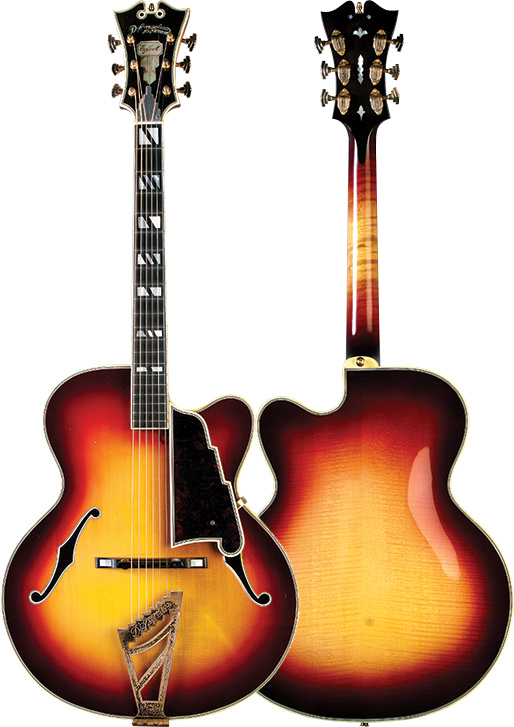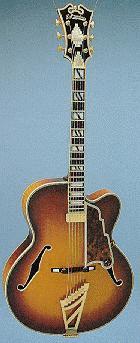I played an Epi MIK Broadway for a number of years. I took advantage of GC's blow out sale on D'Angelico MIK Excel EXL-1. In this case the D'Angelico far exceeded the Broadway. Materials are superior, in my case an ebony versus rosewood fingerboard and flamed versus non-flamed maple on the Epi. PRICE: $1,859 list/$1,149 street. MAKER: D'Angelico Guitars: (732) 662-1912; dangelicoguitars.com. EDITORS' IMPRESSIONS: TEJA GERKEN: Because playing a vintage D'Angelico is a special experience, I was skeptical of a factory-built guitar with such a celebrated name and a price tag of just over $1,000, but I was impressed by how well the EXL-1 captures the D'Angelico spirit.
- Apr 30, 2016 My EXL is 17.5 inches wide and came with a really nice case that's also humongous. Scale is the key here. Montgomery played 25.5 and Pass played 24.5. The D'Angelico is 25.5 - you wrestle it when you're cookin'. No one talks about how beautiful and great playing the current D'Angelico's are and that's weird.
- SPG builds D'Angelico's Standard Series/Excel Series, introduced in 2005. For help dating, see Serial Numbers.
| Born | 1905 |
|---|---|
| Died | September 1, 1964 (aged 58–59) |
| Nationality | United States |
| Occupation | Luthier |
| Known for | Founder of D'Angelico Guitars |
D'angelo Guitars
John D'Angelico (Little Italy, Manhattan, 1905 – Manhattan, September 1, 1964) was a luthier from New York City, noted for his handmade archtopguitars and mandolins. He founded the D'Angelico Guitars company, where other notable luthiers like Jimmy D'Aquisto served as apprentices.
Luthiery[edit]
John D'Angelico was born in 1905 in New York to an Italian-American family, and was apprenticed in 1914 to his great-uncle, Raphael Ciani, who made violins, mandolins, and flat top guitars.[1][2][3] This apprenticeship would become the basis for construction principles he later incorporated into his archtop guitars.[4] After Ciani died D'Angelico took over the management of the business, but he didn't like having to supervise the 15 employees. Iphone data recovery software full version free download mac. As a result, he left and founded in 1932 D'Angelico Guitars at 40 Kenmare Street in Manhattan's Little Italy.[5][6] Here he began making guitars initially based on the 16 inch Gibson L-5 and subsequently working on his own designs.
Instrument designs and output[edit]
Initially D'Angelico's guitars were based largely on the 1920s version of the Gibson L-5 with a 16 inch lower bout and 'snakehead' headstock design, but by 1937, he had settled on four main f-hole archtop guitar designs, heavily influenced by the GibsonL-5:[7][8]
The game features both modes such as, hostage rescue, bomb defusal, and modes such as cooperative campaign missions and base defending. Counter-strike old version download.

- Style A – 17 inch body. Phased out in the 1940s.
- Style B – 17 inch body. Phased out in the 1940s.
- Excel – 17 inch body
- New Yorker – 18 inch body. Approximately 300 made.[9]
Through at least the late 1930s, D'Angelico's guitar necks had non-adjustable steel reinforcement. Later models had functional truss rods.[10] By the late 40s, D'Angelico was building only the Excel and the New Yorker. All New Yorker models featured pearl inlays in the headstock and fingerboards, as well as quadruple bindings.[11]
All of D'Angelico's guitars were hand-built, and many were customized for specific people, so substantial variation is evident in his output. D'Angelico's shop rarely made more than 30 guitars per year.[12] In all, it is estimated that he built 1,164 guitars.[13] D'Angelico also built a few round-hole (as opposed to f-hole) archtops, and a few mandolins.
While D'Angelico's craftsmanship was not always exemplary, the performance of his guitars established him as the premier maker of archtop guitars.[3] During the late 1930s, when production was at its peak, D'Angelico made approximately 35 instruments per year with the help of only two workers, one of whom was Vincent 'Jimmy' DiSerio.[3][14][4] His recognition as the 'finest builder of archtop guitars' later brought offers from larger companies, but ultimately he decided to keep his operation under his own name.[4][14]
During the 1950s, some of the instruments leaving D'Angelico's shop had mixed features, such as an Excel-sized guitar with New Yorker features created for Johnny Smith, or D'Angelico necks custom fitted to bodies customers brought in.[15] Original D'Angelico guitars are identified by a serial number punched inside the bass f-hole—the serial numbers ranging from 1001 to 2164.[15]
In 1952 Jimmy D'Aquisto joined the company as an apprentice.[3]
D'Angelico had a heart attack in 1959 and also parted ways with DiSerio, who left to work at the Favilla guitar company. As a result, he closed the business but soon reopened it after D'Aquisto who was unable to find work, convinced him to do so.[3] After several more heart attacks and having also suffered from pneumonia John D'Angelico died in 1964 at the age of 59. He had built 1,164 numbered guitars with the last ten finished by D'Aquisto.[3][16] D'Aquisto then bought the business but a poor business decision lost him the right to the D'Angelico name.[17]

- Style A – 17 inch body. Phased out in the 1940s.
- Style B – 17 inch body. Phased out in the 1940s.
- Excel – 17 inch body
- New Yorker – 18 inch body. Approximately 300 made.[9]
Through at least the late 1930s, D'Angelico's guitar necks had non-adjustable steel reinforcement. Later models had functional truss rods.[10] By the late 40s, D'Angelico was building only the Excel and the New Yorker. All New Yorker models featured pearl inlays in the headstock and fingerboards, as well as quadruple bindings.[11]
All of D'Angelico's guitars were hand-built, and many were customized for specific people, so substantial variation is evident in his output. D'Angelico's shop rarely made more than 30 guitars per year.[12] In all, it is estimated that he built 1,164 guitars.[13] D'Angelico also built a few round-hole (as opposed to f-hole) archtops, and a few mandolins.
While D'Angelico's craftsmanship was not always exemplary, the performance of his guitars established him as the premier maker of archtop guitars.[3] During the late 1930s, when production was at its peak, D'Angelico made approximately 35 instruments per year with the help of only two workers, one of whom was Vincent 'Jimmy' DiSerio.[3][14][4] His recognition as the 'finest builder of archtop guitars' later brought offers from larger companies, but ultimately he decided to keep his operation under his own name.[4][14]
During the 1950s, some of the instruments leaving D'Angelico's shop had mixed features, such as an Excel-sized guitar with New Yorker features created for Johnny Smith, or D'Angelico necks custom fitted to bodies customers brought in.[15] Original D'Angelico guitars are identified by a serial number punched inside the bass f-hole—the serial numbers ranging from 1001 to 2164.[15]
In 1952 Jimmy D'Aquisto joined the company as an apprentice.[3]
D'Angelico had a heart attack in 1959 and also parted ways with DiSerio, who left to work at the Favilla guitar company. As a result, he closed the business but soon reopened it after D'Aquisto who was unable to find work, convinced him to do so.[3] After several more heart attacks and having also suffered from pneumonia John D'Angelico died in 1964 at the age of 59. He had built 1,164 numbered guitars with the last ten finished by D'Aquisto.[3][16] D'Aquisto then bought the business but a poor business decision lost him the right to the D'Angelico name.[17]
The D'Angelico Guitars brand has continued under other owners. Full version microsoft office for mac free alternative.
Employees[edit]
Some of D'Angelico's employees went on to become craftsmen in their own right. Among them were Jimmy Di Serio, who worked for D'Angelico from 1932–1959, and D'Aquisto who would eventually buy the business from the D'Angelico family. D'Angelico and D'Aquisto are generally regarded as the two greatest archtop guitar makers of the 20th century.[18]
In 2011, works by D'Angelico and D'Aquisto were included in the 'Guitar Heroes' exhibition at the Metropolitan Museum of Art in New York City.[19]
Vincent 'Jimmy' DiSerio, was commissioned by Ralph Patt to modify a GibsonES-150 (six-string archtop hollow-body guitar) to have a wider neck, wider pickup, and eight strings circa 1965; seven strings enabled Patt's major-thirds tuning to have the E-E range of standard tuning, while the eighth string enabled the high A♭.[20]
See also[edit]
Notes[edit]
Serial Numbers For Computer Games
- Peterson, Jonathon (2002). 'Tuning in thirds: A new approach to playing leads to a new kind of guitar'. American Lutherie: The Quarterly Journal of the Guild of American Luthiers. 8222 South Park Avenue, Tacoma WA 98408: USA.: The Guild of American Luthiers. Number 72 (Winter): 36–43. ISSN1041-7176. Archived from the original on 21 October 2011. Retrieved 9 October 2012.CS1 maint: location (link) CS1 maint: ref=harv (link)
References[edit]
- ^Bonds, Ray (ed.) (2006). 'The illustrated directory of guitars.' Barnes & Noble/Salamander Books, p. 104.
- ^Wheeler, Tom (1982). American guitars: an illustrated history.' Harper & Row. p. 22.
- ^ abcdefAcoustic Guitars: The Illustrated Encyclopedia. New York: Chartwell Books. 2011. pp. 38–42. ISBN978-0-7858-3571-4.
- ^ abcWilliam), Green, Frank W/m (Frank (2008). D'Angelico : John D'Angelico : master guitar builder : what's in a name?. Centerstream. ISBN9781574242171. OCLC191808803.
- ^Will Levith (January 23, 2015). 'Joe Bonamassa and the Amazing Technicolor D'Angelico Shop'. Archived from the original on April 4, 2015. Retrieved April 1, 2015.
- ^Teddy Kim (August 22, 2014). 'Rock On! D'Angelico Guitars Is Back in Business in Chelsea'. Retrieved April 1, 2015.
- ^Bonds, Ray (ed.) (2006). p. 104.
- ^Achard, Ken (1999). 'The History and Development of the American Guitar.' The Bold Strummer, p. 16.
- ^Denyer, Ralph (1998). 'The guitar handbook.' Alfred A. Knopf. p. 47.
- ^Wheeler, Tom (1982). pp. 22-23.
- ^Achard, Ken (1999). p. 16.
- ^Bonds, Ray (ed.) (2006). p. 106.
- ^Wheeler, Tom (1982). pp. 22.
- ^ ab'About | D'Angelico Guitars'. angelicoguitars.com. Retrieved 2017-06-09.
- ^ abAchard, Ken (1999). p. 43.
- ^'NAMM 2015: Revived D'Angelico guitar brand shows off new acoustics'. January 23, 2015. Retrieved April 1, 2015.
- ^Stern, Stephen (Fall 1995). 'Jimmy D'Aquisto – Luthier Extraordinaire'(PDF). Frontline magazine. Retrieved March 3, 2019.
- ^'Images from the Lillibridge Gallery'. D'Angelico/D'Aquisto/Gudelsky Workshop. National Music Museum; The University of South Dakota 414 East Clark Street Vermillion, SD 57069. September 8, 2009. Retrieved December 4, 2012.
- ^'Guitar heroes: Legendary craftsmen from Italy to New York, February 9-July 4, 2011'. John D'Angelico. The Metropolitan Museum of Art, New York. Retrieved December 4, 2012.
- ^Peterson (2002, p. 37)
External links[edit]
| Wikimedia Commons has media related to John D'Angelico. |
